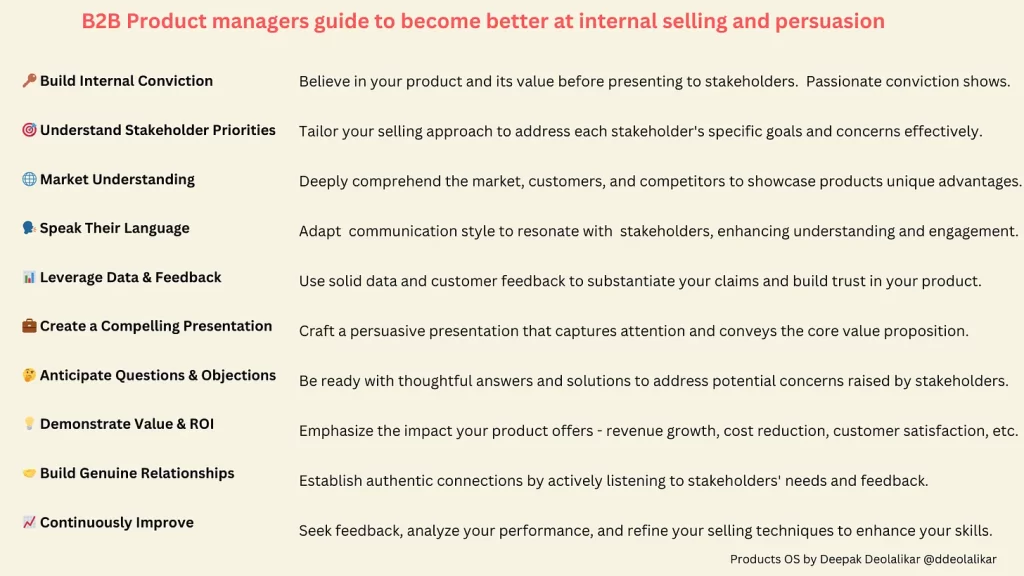How to work on your internal selling and persuasion skills

Hi PMs
You have read quite a bit about the importance of stakeholder management. In order to get your product to market, you have to work with your internal stakeholders – sales, marketing, finance, partners, executive, legal etc.
But what does it really mean to manage stakeholders. In my experience, a critical component of stakeholder management is the ability to persuade them to your own point of view. It’s not just about maintaining relationships with stakeholders but getting them to your side. You need your internal stakeholders to root for you when you are launching your product.
B2B Product managers wear multiple hats. And one of the hats is a sales hat.
Yes, you are always in selling mode. I am not talking about traditional customer sales with quotas. But selling your ideas internally.
As a PM, you work on the product strategy, roadmap and decisions that need to be implemented by engineering and the rest of the company. To execute on your ideas you have to convince others in your organization and bring them along with you on the journey.
Sell to executives : First and foremost, you have to convince the executive team and your own management on your ideas and your strategy. Your roadmap needs to be aligned to the business strategy. You have to convince that the roadmap will create the business impact the company is expecting.
Sell to Engineering: You have to get your dev team aligned on your priorities. In most cases, engineering will follow the product management lead. In my experience, it is always better to get them aligned early on. Good engineering teams always provide good ideas of their own and alternate ways of delivering product. Maybe they have dependencies that could be blocking your vision. As a good PM, you should take that into account in your product vision and get their buy in. Earlier the better.
Sell to Designers: Designers play an important in shaping your products’ experience. Ensure they are in alignment with your vision and the desired customer experience. They are very skilled at taking the customer experience to the next level provided they are intimately familiar with the end objectives.
Sell to Sales and Marketing:A well designed product is useless if it does not get into the hands of the customers. Sales and marketing are the experts in creating the messaging, generating the demand and closing deals with customers. However, they need to be convinced on the value proposition your product is offering so they can apply the same conviction in their messaging and positioning.
You sometimes have to persuade other departments like finance and legal as well.
I once launched a product that required product marketing, finance, legal, operations, PR and channel teams to work in tandem. Each of them had specific actions they had to take in a specific sequence. For example, I needed finance to open a new SKU item in their finance systems so that at launch time, sales people can book sales for the new product. If they miss out, then sales will not be able to sell and we could miss opportunities. Similarly, I needed legal to complete the modified T&C and privacy policy which the new product required. If they did not update on time, we could not launch. And so on and on. This meant that I had to make sure they understood the gravity of the task and ensure they do it. Remember, these people have their regular day jobs to do. These are tasks that are important to me, but not to them. This is where influence without authority aspect of your PM skill kicks in.
Becoming a skilled seller involves mastering key aspects to win over stakeholders and drive successful outcomes. Here are some tips to excel in internal selling:
Create Internal Conviction First: Before presenting to stakeholders, build a strong internal conviction about your product. Understand its value, potential, and how it aligns with the company’s objectives. Passion and belief in your solution will reflect in your pitch and will become infectious.
Understand Executive and Stakeholder Priorities: Tailor your selling approach to cater to the specific priorities and concerns of each stakeholder. Knowing their goals and challenges allows you to position your product as a solution to their needs.
In-Depth Market Understanding: Develop a comprehensive understanding of the market landscape, customer needs, and competitor offerings. This knowledge empowers you to showcase your product’s unique advantages effectively.
Speak the Language of Stakeholders: Adapt your communication style to resonate with different stakeholders. Whether it’s executives, technical teams, or sales representatives, conveying your message in their language enhances understanding and engagement.
Leverage Solid Data and Customer Feedback: Data-driven insights and customer feedback lend credibility to your selling points. Numbers, statistics, and testimonials substantiate your claims and instill trust in the product.
Create a Compelling Presentation: Craft a persuasive and impactful presentation that captures attention and delivers the core value proposition of your product. Keep it focused, well-structured, and visually appealing.
Anticipate Questions and Objections: Put yourself in the shoes of your audience and anticipate potential questions or objections they might raise. Be prepared with thoughtful answers and solutions, showing your readiness to address concerns.
Demonstrate Value and ROI: Emphasize the return on investment (ROI) that your product offers. Showcase how it contributes to revenue growth, cost reduction, customer satisfaction, and overall business success.
Build Genuine Relationships: Establish authentic connections with stakeholders by actively listening to their needs and feedback. Building relationships based on trust and understanding fosters long-term support for your product.
Continuously Improve: Selling is an ongoing learning process. Seek feedback, analyze your performance, and continuously improve your selling techniques.
One of the hallmarks of great product managers is their ability to persuade and become good at internal selling. Like all other skills, this can be learned and practiced. Most of us PMs come from technical backgrounds and hence selling and persuasion is not a natural skill for us. But I argue, this is one skill you don’t want to skimp on. Use the method I described above and slowly practice it.


